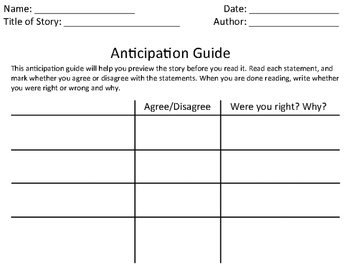The first strategy I liked from tonight's class was the Analogy Chart. I liked how it had you compare two concepts and it had you give a summary of the new concept. It also has you compare what is similar and different about the two concepts. It gives students a chance to relate a new concept, to something they already know. We can use these in reading, math, science, social studies, and writing. This would be a good sheet to help them brainstorm their writing topics for a paper.

I also liked the anticipation guides. I think this is a good way to test their prior knowledge, as well as what they learned after the lesson. We could use this in a math lesson plan to test if they knew the vocab terms before we learned them.








I like the anticipation guide. Not only will it introduce the topic of the unit, but you can use it as a pre-assessment to see what areas in the lesson/unit that you need to spend more time on. It also serves as a post-assessment for student growth and increased understanding.
ReplyDeleteI agree with Susan about the Anticipation Guide, it really does give a good idea of your students' prior knowledge with any subject. Using it for a post assessment is always a good idea, so you can see what students have learned. Myself, I think the Analogy Charts really give students an in-depth look into any subject(s) you want to discuss with your class. Students have to break down the subject in order to find their similarities and differences, which gives them time to fully understand the subject(s). Great job Rachel!
ReplyDeleteRachel,
ReplyDeleteI enjoyed reading your post! I did not even think about being able to use math/algebra with anticipation guides. I love this idea! Also, I have to agree with Susan and Kaitlyn on using them as pre-assessments to see what students know prior to a lesson. It could be used as a closer for one lesson and used to create the next day's lesson so you are not teaching the same information the students already may know. Great ideas!
Michelle
I didn't talk about anticipation guides, but I could see this being used in history also. You could put a statement and then have the students put their input. Then read the section and then have the students go over the guide and see what they got correct and wrong. You could then state the importance of each answer and discuss with the students.
ReplyDelete